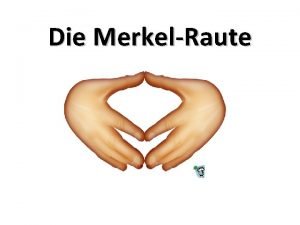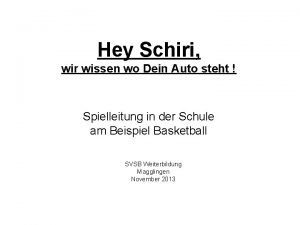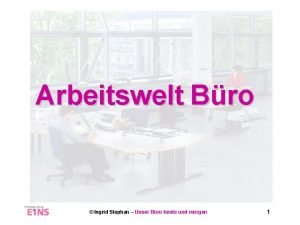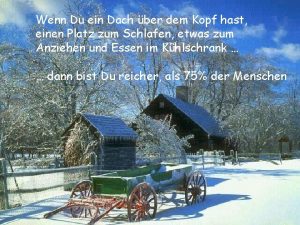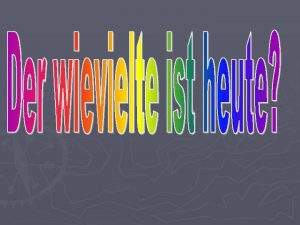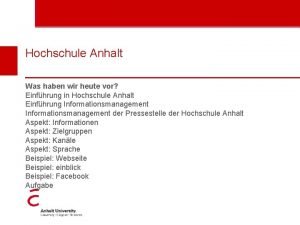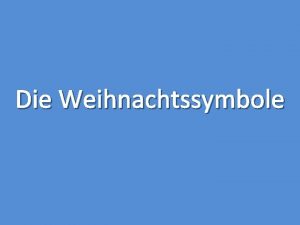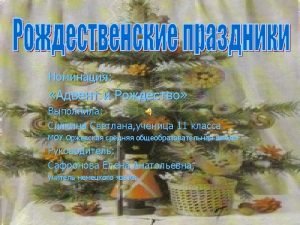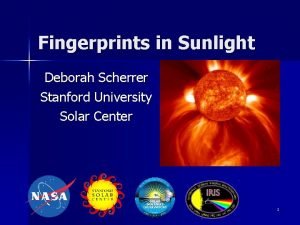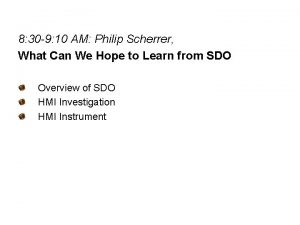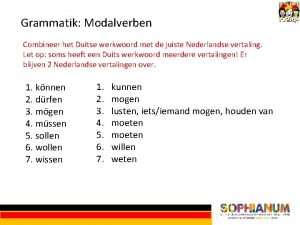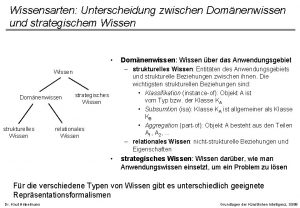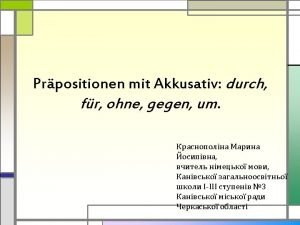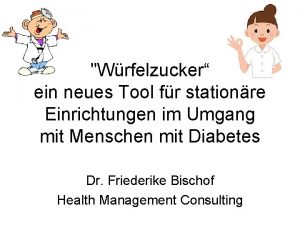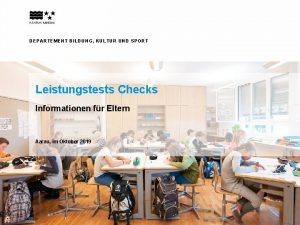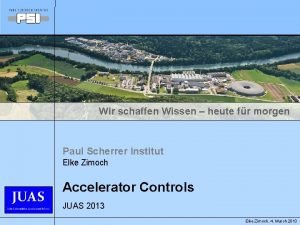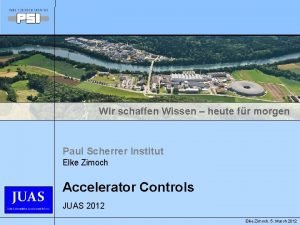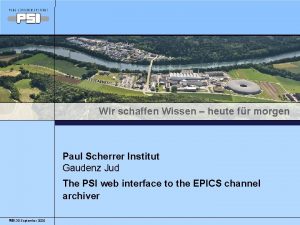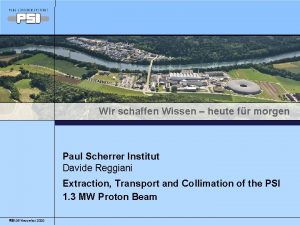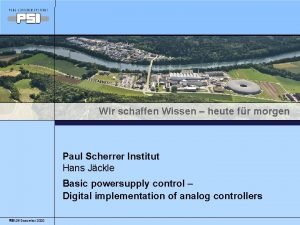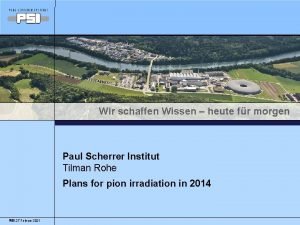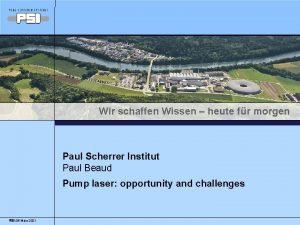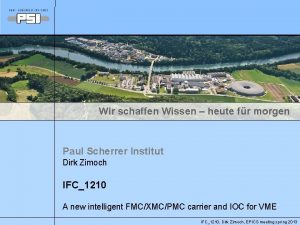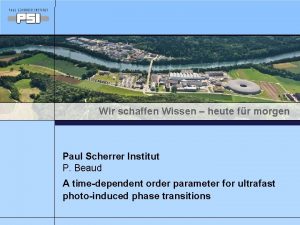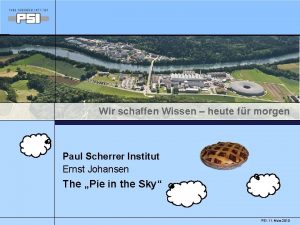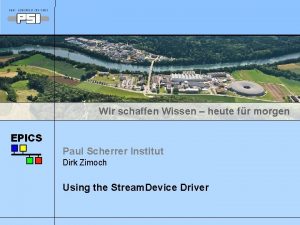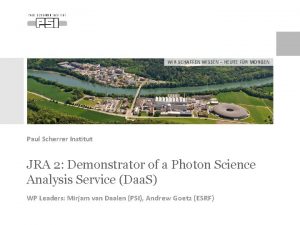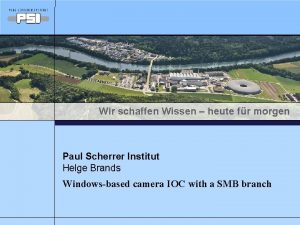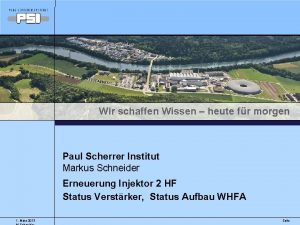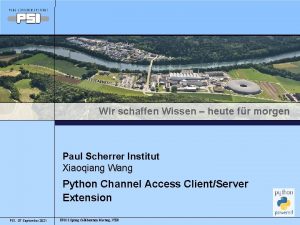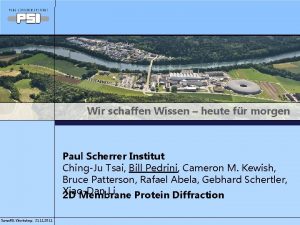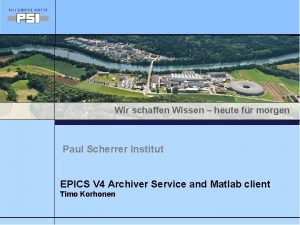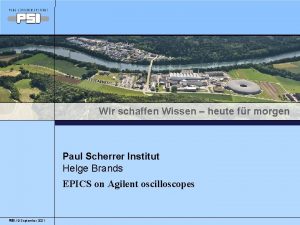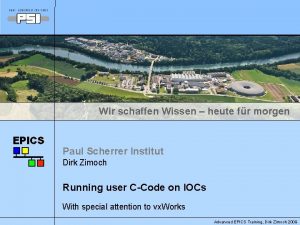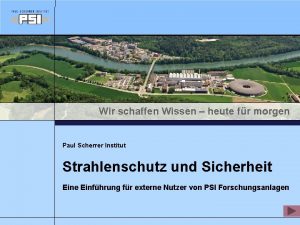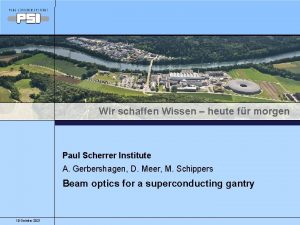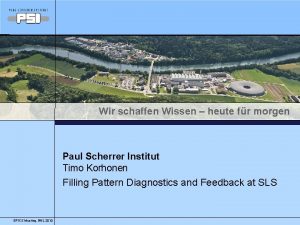Wir schaffen Wissen heute fr morgen Paul Scherrer














![Swiss. FEL Quadrupole Specs QFD + QFF Length [mm] Aperture [mm] Gradient [T/m] Pole Swiss. FEL Quadrupole Specs QFD + QFF Length [mm] Aperture [mm] Gradient [T/m] Pole](https://slidetodoc.com/presentation_image/e70b8cad4eb4be9e7732e722c9ed5a0f/image-15.jpg)








- Slides: 23

Wir schaffen Wissen – heute für morgen Paul Scherrer Institut Marco Negrazus Magnets for the Swiss. FEL: From Beam Specifications to Magnetic Tests PSI, 7. Oktober 2020

Contents • Swiss. FEL Magnets: Two Examples • Swiss. FEL Overview • Bunch compressor Dipole AFBC 3 (Specs, Design, Measurement Results) • Linac and Undulator Quadrupoles QFD + QFF (Specs, Design, Measurement Results)

Swiss. FEL: Target values of the Bunchlength σz Version 7 – 04. 03. 14 Athos Beam Dump 288 µC/hour; 3. 8 Ge. V 2. 5 - 3. 4 Ge. V, 3 k. A 399 m Energy tuning C band (8 x 2 m) max 28. 5 MV/m, 0 º Gun S band 100 MV/m 51 º from 0 crossing Booster 1 Laser Heater Θ = 4. 2 º U 50; l=0. 4 m S band (2 x 4 m) 14/16 MV/m 0/0º R 56 = -55 mm Θ = 3. 8 º σδ = 1. 07 % Linac 1 BC 1 Booster 2 S band (4 x 4 m) 15 MV/m 24 º Deflector X band (2 x 0. 75 m) 15 MV/m + 176 º Athos Linac R 56 = -20. 7 mm BC 2 Θ = 2. 15 º σδ = 0. 57 % Beam Stopper BC 2 C band (36 x 2 m) 26. 5 MV/m, 19. 3 º Switch Yard Linac 2 PSI, 7. Oktober 2020 Athos Undulators 12 x 4 m; gap 24 - 6. 5 mm λu = 40 mm; K= 1 - 3. 2; LU= 58 m Deflector C band (16 x 2 m) 27. 5 MV/m, 0 º Linac 3 0. 7 - 7 nm, 100 Hz; 360 μJ > 1 nm: transform limited Athos Beam Stopper 9 µC/hour 3. 8 Ge. V max. Collimation Injector Beam Dump 288 µC/hour; 1 Ge. V Energy tuning C band (52 x 2 m) max 28. 5 MV/m, 0 º 273 m 3. 0 Ge. V σδ = 0. 34 % εN, proj. = 0. 47 μm 80 m 320 Me. V, 154 A σz = 124 μm (413 fs) z = 18 m; E = 150 Me. V, I = 20 A σz = 871 μm (2. 9 ps) σδ = 0. 15 % εN, slice = 0. 23 μm εN, proj. = 0. 27 μm 466 m Deflector Aramis Beam Stopper 9 µC/hour 7 Ge. V max. 1 (0. 8) - 7 Å 5 – 20 fs; 100 Hz; 150 μJ Aramis Undulators 568 m Aramis Beam Dump 288 µC/hour 7 Ge. V 510 m 2. 1 - 5. 8 Ge. V, 3 k. A σz = 6. 2 μm (21 fs) σδ = 0. 006 % εN, slice = 0. 29 μm εN, proj. = 0. 51 μm 210 m 2. 1 Ge. V; 3 k. A σz = 6 μm (21 fs) 12 x 4 m; gap 3. 2 – 5. 5 mm λu = 15 mm; K= 1. 2; LU= 58 m Seite 3

Bunch Compressor Chicane PSI, 7. Oktober 2020 Seite 4

AFBC 3 Dipole Specs Length Beam Energy Bending Angle Gap B max I max U max Power max Windings Conductor Delta T GFR (integrated) PSI, 7. Oktober 2020 0. 50 m 2. 1 Ge. V 0 – 3. 8 Degree 22 mm 0. 96 T 150 A 12. 6 V 1. 88 k. W 2 x 57 8 x 5 mm 10. 5 °C +- 5 * 10^-5, +- 20 mm Seite 5

AFBC 3 Design 430 mm 550 mm PSI, 7. Oktober 2020 Gap 22 mm Seite 6

Field Optimization AFBC 3 PSI, 7. Oktober 2020 Seite 7

Field Optimization AFBC 3 24 mm 0. 45 mm PSI, 7. Oktober 2020 Seite 8

AFBC 3 Simulated Field Optimization PSI, 7. Oktober 2020 Seite 9

Measured Field Map AFBC 3 PSI, 7. Oktober 2020 Seite 10

Field Integral measurements of 12 AFBC 3 PSI, 7. Oktober 2020 Seite 11

Swiss. FEL Specs for Quadrupoles From the Swiss. FEL TDR: FEL Beam Design Parameters Undulator period (mm) Undulator parameter Energy spread (ke. V) Saturation length (m) Saturation pulse energy (µJ) Effective saturation power (GW) Photon pulse length (fs, rms) Beam radius (µm) Divergence (µrad) Number of photons (× 109) Spectral Bandwidth, rms (%) Peak brightness (# photon/mm 2. mrad 2. s 1. 0. 1% bandwidth) Average brightness (# photon/mm 2. mrad 2. s 1. 0. 1% bandwidth) Nominal Operation Mode Special Operation Mode Long Pulses 15 1. 2 350 47 150 (*) 2. 8 21 26. 1 1. 9 73 0. 05 7. 1032 Short Pulses 15 1. 2 250 50 3 0. 6 2. 1 17 2 1. 7 0. 04 1. 1032 Large Bandwidth 15 1. 2 17000 (FW) 50 100 2 15 26 2 50 3. 5 (FW) 8. 1030 Ultra-Short Pulses 15 1. 2 1000 50 15 50 0. 06 17 2. 5 7. 5 0. 05 1, 3. 1033 2, 3. 1021 5, 7. 1018 3. 1019 7, 5. 1018 Tolerances: Error Undulator Detuning Undulator Misalignment Quadrupole Field Errors Quadrupole Misalignment Injection Jitter (offset or angle) Beta-Mismatch PSI, 7. Oktober 2020 Sensitivity 0. 073% (rms) 83 mm (rms) 20. 96 % (rms) 4. 6 mm (rms) 11. 7 mm (rms) or 0. 78 mrad (rms) 3. 85 d. B Seite 12

Specs of the Quadrupoles QFD + QFF • • Air Cooling to avoid Vibrations Combined Quadrupol + Steerer Funktion in one Magnet 1 k. Hz Bandwidth of the Steerer due to Fast Feedback Low Temperature rise of the Magnets to minimize Axis Drift. Field quality (Higher Harmonics) less important. Small Aperture (QFD: 22 mm, QFF: 12 mm) Mechanically Challenging to keep the tolerances of the Poles Solutions: • Laminated Yoke with low core loss material (M 270 -50) • Slightly big Surface of the Magnet to improve Cooling • Using G 10 Parts to avoid Eddy Currents (downgrades mechanic Stability). PSI, 7. Oktober 2020 Seite 13

Steerer Field of QFD PSI, 7. Oktober 2020 Seite 14
![Swiss FEL Quadrupole Specs QFD QFF Length mm Aperture mm Gradient Tm Pole Swiss. FEL Quadrupole Specs QFD + QFF Length [mm] Aperture [mm] Gradient [T/m] Pole](https://slidetodoc.com/presentation_image/e70b8cad4eb4be9e7732e722c9ed5a0f/image-15.jpg)
Swiss. FEL Quadrupole Specs QFD + QFF Length [mm] Aperture [mm] Gradient [T/m] Pole Tip Field [T] I max [A] P max [W] Cunductor [round mm] Steerer I max [A] Steerer Power [W] QFD 150 22 20 QFF 80 12 50 0. 22 10 50 0. 3 10 39. 4 3 2 x 10 2 x 18. 2 3 2 x 10 2

Linac Section Quadrupole (QFD) G 10 Parts to avoid Eddy Currents PSI, 7. Oktober 2020 Seite 16

QFD + QFF Measured Integrated Field Gradient QFD QFF PSI, 7. Oktober 2020 Seite 17

Rotating Coil Measurements of QFD + QFF QFD QFF PSI, 7. Oktober 2020 Seite 18

Preliminary Temperature Calculations PSI, 7. Oktober 2020 Seite 19

Vibrating Wire Measurements of QFD + QFF PSI, 7. Oktober 2020 Seite 20

Vibrating Wire Measurements QFD 17 DY (micrometers) Quadrupole Axis Distortion due to Steerer Excitation 40 35 30 25 20 15 2 1 10 0. 5 5 0 -30 -25 -20 -15 -10 -5 -5 0 5 10 15 20 25 30 -15 -4 -20 -25 -6 -30 -35 QFD 017; IQ=6 A -40 Positive steering current +Is Negative steering current -Is DX (micrometers) PSI, 7. Oktober 2020 Seite 21

Frequency response of the QFD steerer Measured with a Lock Inn Amplifier with a current amplitude of some 10 m. A. The measuring probe was a coil inside a vacuum chamber in the magnet. Ω Magnetfluss = f(Magnetstrom) 1. 2000 Sensorspannung/Frequenz und normiert auf 100 Hz 1. 0000 0. 8000 0. 6000 97 % at 1 k. Hz 0. 4000 Fluss =. . . 0. 2000 0. 0000 0. 1 1 10 1000 Frequenz [k. Hz] PSI, 7. Oktober 2020 Seite 22

PSI, 7. Oktober 2020 Seite 23
 Wir schaffen das raute
Wir schaffen das raute Schiri wir wissen wo dein auto steht text
Schiri wir wissen wo dein auto steht text Ein neuer tag beginnt bilder
Ein neuer tag beginnt bilder Unser büro heute und morgen
Unser büro heute und morgen Was du heute machen kannst verschiebe nicht auf morgen
Was du heute machen kannst verschiebe nicht auf morgen Wenn du ein dach über dem kopf hast
Wenn du ein dach über dem kopf hast Winter kommt winter kommt flocken fallen nieder lied
Winter kommt winter kommt flocken fallen nieder lied Wievielten haben wir heute
Wievielten haben wir heute Was haben wir heute
Was haben wir heute Wir sind nicht mehr was wir mal waren
Wir sind nicht mehr was wir mal waren Weihnachtssymbole
Weihnachtssymbole Zünden wir ein lichtlein an sagen wir dem weihnachtsmann
Zünden wir ein lichtlein an sagen wir dem weihnachtsmann Solar center stanford
Solar center stanford Phillip a. scherrer
Phillip a. scherrer Dr philip scherrer
Dr philip scherrer Modalverben wollen
Modalverben wollen Wissensarten
Wissensarten Wissen aneignen
Wissen aneignen Wissen prapositionen
Wissen prapositionen Es ist nicht genug zu wissen man muss auch anwenden
Es ist nicht genug zu wissen man muss auch anwenden Was wissen sie über deutschland
Was wissen sie über deutschland Bescheid wissen
Bescheid wissen Individuelles wissen
Individuelles wissen Check dein wissen ergebnisse
Check dein wissen ergebnisse
